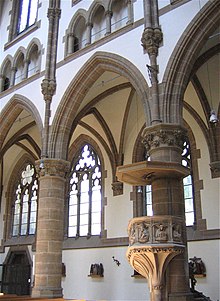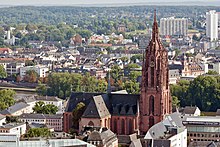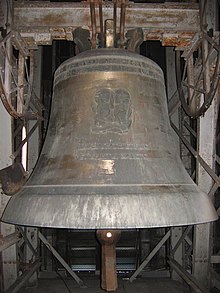St. Paul (Munich)
|
St. Paul in Munich. In the background you can see (from left): St. Michael , the Frauenkirche , on the right St. Peter , Heilig-Geist-Kirche , St. Lukas , Allerheiligenkirche and St. Johann Baptist in Haidhausen . |
|
| Basic data | |
| Denomination | Roman Catholic |
| place | Munich , Germany |
| diocese | Archdiocese of Munich and Freising |
| Patronage | St. Paul |
| Building history | |
| Builder | Central association for church building in Munich |
| architect | Georg von Hauberrisser |
| construction time | June 7, 1892 - June 24, 1906 |
| Building description | |
| inauguration | June 24, 1906 |
| Architectural style | Neo-Gothic |
| Construction type | basilica |
| Function and title | |
| 48 ° 8 '10.8 " N , 11 ° 33' 8.4" E | |
The Catholic Church of St. Paul , also called Paulskirche , is the first parish church in Ludwigsvorstadt in Munich . It was built in the neo-Gothic style from 1892 to 1906 according to plans by Georg von Hauberrisser . With the 97 meter high east tower, St. Paul is not only one of the tallest, but also one of the mightiest churches in Munich , along with the Liebfrauendom .
location
St. Paul stands at the western end of Landwehrstrasse, which was laid out next to Schwanthalerstrasse as one of the major access roads in Ludwigsvorstadt. The Paulskirche at St.-Pauls-Platz 11 closes the Landwehrstraße and attracts the eye, as it dominates the visual axis through its main tower and, as it were, gathers the Ludwigsvorstadt around it. In terms of urban planning, she also makes contact with her mother parish, St. Peter , since the Landwehrstrasse, as it is intended to extend in the direction of the historic old town, leads directly to the "Old Peter".
history
After Munich had grown to around 262,000 inhabitants in 1883, Archbishop Antonius von Steichele demanded the construction of three more parish churches. To enable the construction of these three parish churches of St. Benno in the Maxvorstadt (consecrated in 1895), St. Maximilian in the Isarvorstadt (inaugurated in 1901) and St. Paul, the "Central Association for Church Building in Munich" , known as the Central Church Building Association , was founded should build all three churches. In addition to the central church building association, a local church building association for St. Paul was founded in 1883 and existed until 1914.
On May 30, 1883, the royal capital and residence city of Munich made a building site south of the Schwanthalerschule available free of charge, with the condition that construction should begin within the next 15 years. As the winner of an architecture competition, Georg von Hauberrisser received the building contract. His design is an example of his own neo-Gothic style, which interprets French and Rhenish Gothic in an idiosyncratic manner. The civil engineer Eduard Schneider, who had already been the site manager at the parish church of St. Anna im Lehel , was commissioned with the construction management on May 11, 1892. The curator of the Parish Church Foundation, Domkapitular Dr. Paul Kagerer presented on June 7, 1892 in the presence of the master builder and the committee members of the St. Paul Church Building Association. The foundation stone was finally laid on June 29, 1892 by Archbishop Antonius von Thoma .
The construction of the church proceeded rapidly despite the unfavorable subsoil. After the construction engineer Edmund Schneider died in the second week of December 1893, construction was suspended until April 2, 1894. At that time, Felix Swoboda took over the construction management. Financial problems never led to the cessation of construction, as those responsible in the responsible church building associations could trust the willingness to donate and the proceeds from the church building lotteries.
In 1899 construction was so advanced that the future Marienkapelle could be expanded as an emergency church . The first service was celebrated on November 12, 1899. After the nave was completed in 1900, St. Paul was raised to the position of St. Peter's Expositur . The high altar was consecrated on December 8, 1903, and on February 5, 1905, it was elevated to the status of a parish church. Finally, after all work was completed, St. Paul was inaugurated on June 24, 1906 by Archbishop Franz Joseph von Stein in the presence of Archbishop of Bamberg , Friedrich Philipp von Abert , and the almost complete Wittelsbach royal family under Prince Regent Luitpold .
During the Second World War , St. Paul was badly damaged by the air raids on Munich, particularly in October (4th / 5th) and December (31st) 1944 , with large parts of the furnishings being lost, including the high altar. A choir stalls originally created by Thomas Buscher for St. Paul are now in the Church of the Assumption of Mary in the Upper Franconian town of Teuschnitz . In the 1950s, the Paulskirche was restored and modernized due to the loss of equipment in the taste of the time.
On December 17, 1960, an American military aircraft of the type Convair C-131D Samaritan , which had taken off from Riem Airport and could not gain altitude quickly enough due to an engine failure, grazed the top of the main tower of the church and fell at the nearby Martin- Griffin Street on a tram . The accident resulted in 52 deaths - the 20 aircraft occupants and 32 tram passengers and passers-by (see also the plane crash on December 17, 1960 in Munich ).
Program and concept

The predominant architectural style for new churches around 1890 was the neo-Romanesque style. Above all, there were political reasons for this. After the establishment of the German Empire in 1871, Romanesque was seen as an architectural style that emphasized loyalty to dynastic rule and at the same time constructed a continuity to the Roman-German Empire of the Middle Ages. St. Paul consciously set itself apart from the church buildings of this style, of which the parish church of St. Anna im Lehel and St. Benno Munich-Maxvorstadt and St. Maximilian Munich-Isarvorstadt are to be mentioned in particular by reviving the neo-Gothic style .
That too had political reasons. While the neo-Gothic at the beginning and middle of the 19th century was seen more as an architectural style that, in continuation of the thoughts of Johann Wolfgang von Goethe , which he presented in his hymn to the Strasbourg Cathedral (1773), as a typical "German architectural style" (Goethe) Emphasizing national unity, it turned into an expression of a self-confident and politically independent bourgeoisie , which did not want to follow a strictly hierarchical dynastic principle because it seemed too feudal to them . That is why the magistrate of the royal capital and residence city of Munich, when it had to decide on an architectural style for the New Town Hall on Marienplatz , opted for neo-Gothic, since the heyday of the city of Munich and its citizens would be resumed in the Gothic. At the same time, around 1890, Ludwigsvorstadt was largely an upper -class quarter, with St. Paul itself embedded in a belt of villas. In order to demonstrate this self-confidence, the high main tower (which, by the way, has a very close resemblance to the tower of the Kaiserdom in Frankfurt am Main ), which is not for nothing similar in height to the first building of bourgeois self-confidence and independence, the Frauenkirche , was opposed The tradition is not based on the theologically significant crossing, but built to the east in the direction of the choir in order to dominate the line of sight of Landwehrstrasse from the direction of the city center and the residence. This means that both St. Paul and the New Town Hall, which was built around the same time and whose design also comes from Georg von Hauberisser, are expressions of the self-confident upper class and educated bourgeoisie of Munich who, despite their loyalty to the royal family, insist on their independence and freedom.
Hauberrisser always used architectural details from important medieval buildings in his neo-Gothic buildings. The tower of St. Paul, for example, ties in with the model of the Frankfurt Imperial Coronation Church of St. Bartholomew , thus creating a link with the historical tradition of the Holy Roman Empire . The positioning of the tower motif of Frankfurt's west tower as a quasi “crossing tower” near St. Paul was probably taken over by Hauberrisser from Bayeux Cathedral .
Dimensions of the structure
- Height of the main tower: 97 m
- Height of the two west towers: 76 m
- Total length of the church: 76 m
The building consists mainly of Ansbacher shell limestone for the exterior cladding and tuff stone for the interior work, which comes from Darching near Holzkirchen and Polling near Weilheim i. Obb. Originates. The core of the masonry consists of brick and quarry stone .
Significant works of art
- Tympanum ( Heinrich Waderé , 1902)
- Bridal gate (designed by Georg von Hauberisser, executed in 1896);
- Stations of the Cross ( Georg Busch , 1905–1913)
- Pulpit (designed by Georg von Hauberisser, made after 1900);
Vasa sacra and liturgical implements
The church owns numerous chalices, reliquary vessels, monstrances and liturgical implements from different stylistic epochs from the baroque to modern times.
Neo-Late Gothic monstrance
The monstrance of the initial outfitting period is in the neo-Gothic style and was made by the Munich goldsmith's workshop Harrach & Sohn. It represents a mixture between neo-late Gothic tower monstrance and baroque radiant wreath monstrance, with the details in vegetal ornaments of Art Nouveau . The stone adorned communion wafers-Lunula in an ogee shrine with pinnacles and finial is of two angels from Ivory flanked wearing a silver cross and crown of thorns of Christ as an indication of the sacrificial death of Jesus. The Nodus the monstrance is a gadrooning in driving technique decorated. The Latin words "Posuit Tabernaculum", engraved in Gothic letters , come from the Vulgate and refer to Psalm 19:
“The heavens extol the glory of God, the firmament proclaims the work of his hands. One day tells the other, one night announces it to the other, without words and without speaking, her voice remains inaudible. But their message goes out into the whole world, their news to the ends of the earth. There he built a tent for the sun. She emerges from her room like a bridegroom; she exults like a hero and runs her course. "
"Munich Monstrance"
The modern monstrance, made by goldsmith August Hartle (Munich-Großhadern) in 1960, consists of a chased and gold-plated, approximately egg-shaped brass plate, which is radially set with rock crystals , lapis lazuli , rose quartz and other semi-precious stones . During the 37th World Eucharistic Congress in Munich in 1960, the Holy of Holies was exposed in it for adoration in the parish church of St. Paul. The World Eucharistic Congress in Munich was the first major international event in Germany after the Second World War . It took place under the Latin motto: "Pro mundi vita" (translation: For the life of the world) from July 31, 1960 to August 7, 1960. The unusual egg shape of the monstrance with its radiation pattern could be inspired by the Garching atomic egg , which had been inaugurated shortly before in 1957.
Modern tabernacle
Goldsmith August Hartle also made a tabernacle (gold-plated silver with semi-precious stones, 38 × 75 × 50 cm) to match the monstrance of the Eucharistic World Congress . The tabernacle was originally placed on the sacramental altar that was created at the same time (design: Raimund Thoma) in the south transept. There is currently an image installation by Stefan Hunstein here . The five large rock crystals on the front of the tabernacle are surrounded by radially arranged gemstones and can be understood as a reference to the five holy cross wounds of Jesus during his sacrificial death. On the right side wall of the tabernacle is a red carnelian , which is surrounded by semi-precious stones and can be interpreted as a symbol of the Sacred Heart of Jesus . The left side wall of the tabernacle is designed in rock crystals and is intended to illustrate the unity of God the Father and God Son . The former sacramental altar by Raimund Thoma has been used as the church's celebration altar since the redesign in 2004. Since then, Hartle's tabernacle has been placed on the Marien Altar with the altarpiece by Gabriel von Hackl (1901/1902).
Lecture cross
The brass-studded wooden lecture cross with brass buttons, designed by Hans Thoma around 1960 and manufactured by the Werkstätte für Metallkunst Alois Hackl in Munich-Laim, shows the risen Jesus in a colorful stone mosaic on the front and four rock crystals at the points of Jesus' nail wounds on the front.
Eternal light
The stand for the eternal light made of bronze and red glass was created by Hans Thoma. The execution was carried out in 1960 by the metal art workshop Alois Hackl in Munich-Laim.
Cross reliquary
For blessings , the parish has a baroque cross reliquary, which is said to contain a span from the cross of Christ .
- St. Paul (Munich), Vasa sacra
Organs
Main organ
The main organ was built in 1977 by Wilhelm Stöberl . It has 37 registers on three manuals and a pedal . In 2006 it was renovated by the Munich organ builder Johannes Führer . The disposition was changed slightly. The organ has a cone shutter , the action mechanism and the stop action mechanism are electropneumatic .
The organ has the following disposition:
|
|
|
|
|||||||||||||||||||||||||||||||||||||||||||||||||||||||||||||||||||||||||||||||||||||||||||||||||||||||||||||||||||||||||||||||||
- Coupling : I / P, II / P, III / P, II / I, III / I, III / II, Tutti, Sub III / P, Sub II / I, Super II / I, Sub III / I, Super III / I, Super III / II, Super III
- Playing aids : typesetting system , sequencer
Choir organ
The St. Paul choir organ was manufactured by the Munich organ builder Johannes Führer in 2006. The pitch is 440 or 415 Hz ( transposition device ). The organ has slide chests and has 5 registers and a manual. The game action and the stop action are mechanical. The organ has the following registers: Covered 8 ′, octave 4 ′, flute 4 ′, fifth 2 2 ⁄ 3 ′, octave 2 ′.
Bells
The chime of St. Paul, which is one of the deepest chimes in Munich, consists of six church bells . Its total weight is 13,050 kg. All bells hang in steel belfry on straight steel yokes. Twice a day (at noon and in the evening) at prayer times, bell 5 rings for three minutes. Bell 3 commemorates the hour of Christ's death on Fridays at 3 p.m. The chimes for church services and other occasions follow a chime order that provides for different motifs according to the liturgical calendar. The full bells are mainly heard at high festivals and at the turn of the year.
| No. | Surname | Casting year | Foundry, casting location |
Diameter (mm) |
Mass (kg) |
Nominal | tower |
| 1 | Hosanna | 1958 | Karl Czudnochowsky, Erding | 2030 | 5200 | g 0 | Main tower |
| 2 | Paul | 1958 | Karl Czudnochowsky, Erding | 1720 | 3000 | b 0 | Main tower |
| 3 | martyr | 1958 | Karl Czudnochowsky, Erding | 1520 | 2000 | c 1 | Main tower |
| 4th | Joseph | 1958 | Karl Czudnochowsky, Erding | 1340 | 1350 | d 1 | northwest |
| 5 | Regina Pacis | 1958 | Karl Czudnochowsky, Erding | 1150 | 800 | f 1 | northwest |
| 6th | Orate Fratres | 1901 | Kortler bell foundry, Munich | 700 | g 1 | northwest |
Trivia
- On the 100th anniversary of the inauguration in 2006, the parish started extensive activities, including exhibitions by Jannis Kounellis and Stefan Hunstein .
- Every year at Munich Oktoberfest , numerous people - especially photographers - are drawn to the balustrade -like viewing platform on the main tower. From there you have the world-famous “postcard view” of the Theresienwiese to the south .
literature
- Hans Lembruch: Catholic parish church Paul - Munich . Schnell and Steiner, Regensburg 1994, ISBN 978-3-7954-4912-4 (series: Small art guides / churches and monasteries).
- Michael Andreas Schmid (Ed.): St. Paul in Munich, Lindenberg im Allgäu 2010.
gallery
Web links
Individual evidence
- ↑ Michael Andreas Schmid (ed.): St. Paul in Munich, Lindenberg im Allgäu 2010, pp. 40–41.
- ↑ Heike Schülein: The choir stalls were intended for Munich. inFranken.de, December 19, 2011, accessed on July 20, 2017 .
- ↑ Michael Andreas Schmid (Ed.): St. Paul in Munich, Lindenberg im Allgäu 2010, p. 19.
- ↑ Michael Andreas Schmid (ed.): St. Paul in Munich, Lindenberg im Allgäu 2010, p. 102.
- ↑ Experience community - celebrate the Eucharist, The World Eucharistic Congress 1960 in Munich: Peter Pfister (Ed.), Archive of the Archdiocese of Munich and Freising, AEM, Volume 10, Munich 2010.
- ↑ Information on the main organ at organindex.de, accessed on June 8, 2015.
- ↑ Information on the choir organ at organindex.de, accessed on June 8, 2015.





















